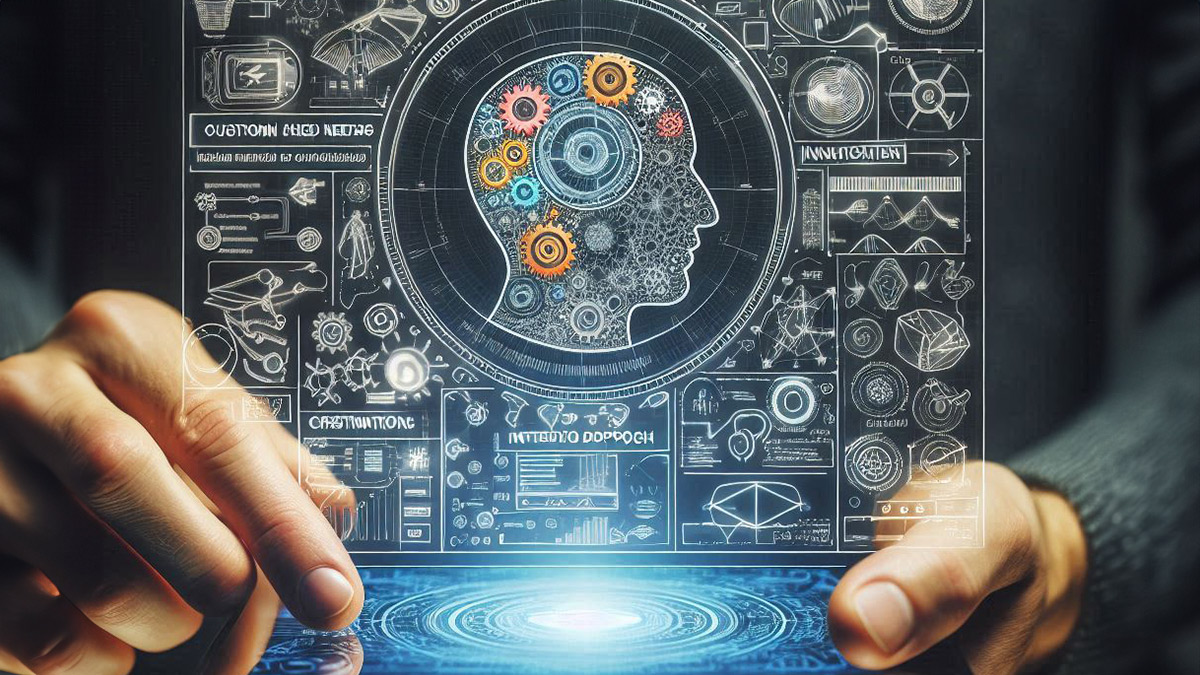How is Artificial Intelligence (AI) enhancing creativity in engineering design? By automating tasks and generating creative design alternatives, AI lets engineers focus on innovative solutions. This article explores the role of AI in engineering design—enhancing creativity—highlighting how it boosts creativity.
Key Takeaways
- AI significantly enhances engineering design processes by improving efficiency, automating data analysis, and facilitating innovative and unique design solutions.
- The collaboration between human designers and AI fosters creativity and allows engineers to focus on higher-level problem-solving, rather than repetitive tasks.
- Emerging AI technologies and trends are set to revolutionize the design industry, necessitating continuous learning and collaboration among professionals to maximize AI’s potential.
Understanding AI in engineering design
Monumental strides in various fields, including engineering, indicate significant advancements in artificial intelligence technology. The relationship between AI and engineering is symbiotic, enhancing problem-solving capabilities and fostering innovation. Harnessing AI’s potential enables designers to unlock new levels of creativity and efficiency, fundamentally reshaping the engineering design landscape.
AI has transformed how designers work, enhancing design processes through increased efficiency and powerful predictive capabilities. Integrating AI in design generates innovative solutions, offering tools that boost efficiency and foster creativity.
Defining AI’s role in engineering design
Before: AI is expected to significantly transform the design process, making tools more intuitive and accessible. Engineers can enhance decision-making by leveraging AI tools. This enables them to deliver impactful designs. AI improves design by automating data analysis and generating alternatives, thus enhancing overall decision-making. AI-driven data analytics tools help engineers streamline predictive modeling. They also assist in risk assessment and performance optimization.
After: AI is expected to significantly transform the design process by:
- Making tools more intuitive and accessible
- Enhancing decision-making for engineers through AI tools
- Automating data analysis and generating alternatives to improve design
- Streamlining predictive modeling with AI-driven data analytics tools
- Assisting in risk assessment and performance optimization
The capabilities of AI allow for the analysis of data and creation of designs autonomously, leading to new ideas. This not only frees engineers from repetitive tasks but also allows them to focus on higher-level decision-making, innovation, and problem-solving. AI tools help engineers generate innovative design alternatives by analyzing vast amounts of design data and user feedback.
Historical evolution of AI in engineering
The initial use of AI in the design industry involved automating repetitive tasks, such as generating design variations or creating prototypes. Over time, AI has become integral to the design industry, signifying a significant evolution in its capabilities. The role of AI has evolved from merely automating repetitive tasks to learning from previous designs and generating unique solutions.
This evolution highlights the transformative power of AI, as it has shifted from basic automation to a more advanced, learning-based approach that drives innovation. The journey of AI in engineering practices reflects broader technological advancements, marking a new era in design optimization and creative problem-solving.
Enhancing creativity with AI
AI enhances engineering processes by boosting problem-solving capabilities and fostering innovation. Integrating AI allows industrial engineers to explore innovative design possibilities previously unimaginable in industrial engineering. Immersive virtual reality is anticipated to further enhance design experiences by providing interactive and engaging environments.
In this section, we will explore how AI-driven design alternatives and collaborative creativity between humans and AI are pushing the boundaries of innovation. Leveraging AI unlocks new levels of creativity and efficiency for designers, making the process more dynamic and impactful.
AI-driven design alternatives
AI is expected to create vast opportunities for innovation in engineering design, fundamentally changing traditional methodologies. Generative AI allows for rapid exploration of design alternatives by using machine learning to meet specified criteria. AI automates data analysis and generates design alternatives, enabling engineers to explore a wide range of innovative solutions quickly.
AI can now learn from past designs, identify patterns, and generate unique design solutions. This ability to generate multiple design options based on specific criteria significantly accelerates the design process, leading to innovative solutions that might be missed with traditional approaches.
Collaborative creativity between humans and AI
AI streamlines workflows, gains insights from data, and explores innovative possibilities. The collaboration between human designers and AI inspires new design directions and pushes the boundaries of innovation. A common misconception is that AI replaces human creativity; however, AI can spark innovative ideas and enhance the creative process.
Harnessing AI allows human designers to focus on creativity while AI manages data-driven tasks, creating a synergy that leads to groundbreaking concepts. This collaboration not only enhances the creative process but also ensures that the final designs are both innovative and practical.
Benefits of integrating AI in engineering design
AI revolutionizes engineering methodologies, offering tools that increase efficiency and foster creativity in design. Integrating AI into the design process results in enhanced efficiency, productivity, creativity, and innovation. The partnership between human designers and AI facilitates a creative synergy, merging emotional intelligence with data-driven insights.
In this section, we will discuss the benefits of integrating AI in engineering design, such as increased efficiency, productivity, and cost-effectiveness. We will also explore how AI optimizes workflows and enhances creativity, leading to innovative design directions that extend beyond traditional limits.
Increased efficiency and productivity
AI-driven tools streamline data analysis, enabling engineers to dedicate more time to creative tasks. AI algorithms can generate a wide range of design options quickly, enabling engineers to explore various innovative solutions. AI tools can optimize construction project timelines by accurately predicting delays and resource allocation using optimization algorithms.
Offloading routine tasks to AI allows designers to work more efficiently and deliver designs faster. The integration of AI not only reduces the time spent on repetitive tasks but also fosters innovation through enhanced efficiency.
Cost effectiveness and resource optimization
Integrating AI into design processes can lead to substantial reductions in operational costs. AI improves construction schedules by analyzing data to anticipate delays and optimize resource allocation. AI tools enhance resource allocation by analyzing usage patterns and predicting needs.
The integration of AI for cost reduction and resource optimization enables more innovative and sustainable designs. This not only improves energy efficiency but also ensures that resources are used more effectively, leading to significant operational efficiency, cost savings, and better project outcomes.
Challenges and considerations in using AI for creative design
It is crucial to address ethical considerations, data biases, and the importance of transparency when integrating AI into the design process. Collaboration among designers, AI specialists, and industry stakeholders is vital for navigating the AI-driven design landscape. Continuous education and adaptation to emerging AI technologies are essential for engineers to succeed in the evolving design industry.
This section discusses the challenges and considerations of using AI in creative design, focusing on ethical issues and the need for technical expertise and training. Addressing these challenges enables engineers to harness AI’s full potential while ensuring ethical and responsible use.
Ethical considerations and building trust
Transparency in AI systems is crucial to establish trust among users, as it allows stakeholders to understand how AI decisions are made. User privacy must be upheld in AI applications to ensure that stakeholder data is protected and handled with care.
Addressing bias in AI systems is essential to uphold human values and ensure fair treatment of all users, thereby reducing disparities in outcomes. By prioritizing transparency, user privacy, and bias reduction, organizations can build significant trust among their stakeholders.
Technical expertise and training
Ongoing education and specialized training in AI tools are vital for engineers to leverage AI effectively in their design processes. A strong foundation in technical skills and knowledge specific to AI tools is indispensable for effective AI use in design software.
Designers need a set of technical skills and knowledge specific to AI tools to utilize them effectively. By investing in continuous education and training, engineers can stay updated on AI developments and ensure they are well-equipped to harness the full potential of AI in their design practices.
The future of AI in engineering design
The future exploration of AI in design involves predicted trends and preparations for an AI-driven design industry. There are immense possibilities for an AI-driven design industry, showcasing how AI can further enhance creativity and innovation.
This section examines emerging trends and technologies in AI for engineering design and discusses how engineers can prepare for an AI-enhanced industry. Staying ahead of these trends enables engineers to leverage AI for significant advancements in their fields.
Emerging trends and technologies
Emerging AI technologies are set to introduce AI-generated design variations, which will allow engineers to explore a broader range of creative possibilities in their design processes. Immersive virtual reality design experiences will become more common, offering engineers the chance to engage with their designs like never before, enhancing interaction and innovation.
AI-powered design assistants are being developed to help engineers streamline their creative processes, providing real-time insights and suggestions to aid decision-making. Adapting to these emerging trends is crucial for engineers to remain competitive and harness the full potential of AI in their design practices.
Preparing for an AI-enhanced design industry
In the AI-driven design industry, engineers need to embrace lifelong learning. They must also stay informed about the latest advancements in AI. Engineers must adapt to rapid AI advancements to remain competitive in the evolving design landscape.
Collaboration is essential for navigating the evolving landscape of AI in design. This requires the teamwork of designers, AI experts, and stakeholders. Custom AI models developed in-house can ensure proprietary design knowledge remains secure and enhance design consistency.
Summarizes the key points of the article and concludes with an inspiring message about the future of AI in engineering design. This section will highlight the transformative impact of AI and encourage readers to embrace the opportunities it presents.
Frequently Asked Questions
How does AI enhance creativity in engineering design?
AI significantly enhances creativity in engineering design by automating repetitive tasks and generating numerous design alternatives swiftly. This allows engineers to concentrate on innovative ideas and explore a broader spectrum of creative solutions.
What are some real-world applications of AI in engineering design?
AI plays a crucial role in engineering design through applications such as predictive maintenance in manufacturing, which minimizes downtime and extends the life of equipment, and generative design, which accelerates innovation. In civil engineering, AI tools improve structural safety and optimize construction scheduling, enhancing overall project efficiency.
What are the benefits of integrating AI in engineering design?
Integrating AI in engineering design significantly enhances efficiency, productivity, and cost-effectiveness by optimizing workflows and automating repetitive tasks. This allows engineers to concentrate on creativity while improving resource allocation and construction schedules for more innovative and sustainable designs.
What challenges should be considered when using AI in creative design?
When utilizing AI in creative design, it is essential to address ethical considerations like transparency, user privacy, and bias in AI systems. Building trust among stakeholders and fostering collaboration among designers, AI specialists, and industry participants are also crucial to successfully navigating this evolving landscape.
How can engineers prepare for an AI-enhanced design industry?
Engineers must embrace lifelong learning and adapt to advancements in AI to remain competitive in the design industry. Collaborating with AI experts and developing in-house AI models will also protect proprietary knowledge and enhance design consistency.





0 Comments